The main distinction between Ramen and Udon is that Ramen is always served hot, while Udon can be served either hot or cold. Both are popular Japanese noodle dishes, with Ramen being a noodle soup made from Chinese-style wheat noodles and Udon being a thick, soft, white Japanese noodle. Udon noodles are generally thicker than Ramen noodles. Additionally, Ramen uses a heavy topping because the noodle is thin, while Udon uses a simple topping due to its thickness.
Key Takeaways
- Ramen is always served hot, whereas Udon can be served hot or cold.
- Udon noodles are thicker than Ramen noodles, and Udon uses a simple topping because of its thickness.
- Ramen originated in China but has evolved in Japan for over 100 years, while Udon is a traditional Japanese noodle dish.
What is Ramen?
Ramen, though a famous Japanese dish, is believed to have originated in China. It has been evolving in Japan for more than a century and is known for being tasty, popular, and affordable. The main ingredients of ramen noodles include wheat flour, water, salt, and kansui, which gives the noodle a slight yellow color. Ramen noodles can be thin or thick, long or short, and curly or straight.
Ramen is typically served in a hot broth made from meat, fish, or vegetables. Meat-based broths are made from beef bones, pork bones, or kelp, and are flavored with miso paste or soy sauce. Various toppings can be added, such as egg, sliced pork, nori, corn, butter, green onions, carrots, or bamboo shoots, with seasonings like chili peppers, white pepper, black pepper, crushed garlic, and sesame seeds. The calorie content of this dish can range from 200-600, depending on the toppings, broth, and ingredients used. Different regions of Japan have different Ramen dishes with unique tastes.
Ramen is also available as low-cost instant noodle packages, which contain pre-cooked noodles and a seasoning packet in various flavors. However, these packages have a higher sodium content compared to restaurant or homemade Ramen dishes, which use fresh ingredients and have lower sodium levels.
What is Udon?
Udon is a thick, soft, white Japanese noodle made from wheat flour, with a smooth texture and subtle taste. It can be served hot or cold, and if served cold, it should include a dipping sauce. Toppings vary depending on the region, but common ones include tempura, scallions, prawn, shrimps, kamaboko, and aburaage. Cold Udon can also be garnished with fresh vegetables, shredded chicken, and slices of egg omelettes.
Udon noodles easily absorb the taste of their broth, so the flavor can be easily enhanced. The broth can be either light or dark brown, depending on the region in Japan. Light brown broths are common in Western regions, while dark brown broths are more common in Eastern regions. Udon soup broths, known as kakejiru, are light and flavored with soy sauce, mirin, and dashi. Chicken can also be used to make chicken udon. There are various types of Udon, such as Tempura Udon, Curry Tempura, Stamina Udon, Zaru Udon, and Kake Udon.
What is the Difference Between Ramen and Udon?
The primary difference between Ramen and Udon is that Ramen is always served hot, while Udon can be served hot or cold. Additionally, there are other differences between the two based on their preparation, size, and shape. The following infographic lists the differences between Ramen and Udon in tabular form for side-by-side comparison.
Summary – Ramen vs Udon
Both Ramen and Udon are famous Japanese dishes. Ramen is a yellow noodle that uses a heavy topping due to its thinness and can be either curly or straight. It is made with eggs and kansui. Udon is a white, thick noodle that is usually straight, and because of its thickness, the whole meal takes a simple form. Udon can be served hot or cold. Thus, this is the summary of the difference between Ramen and Udon.
